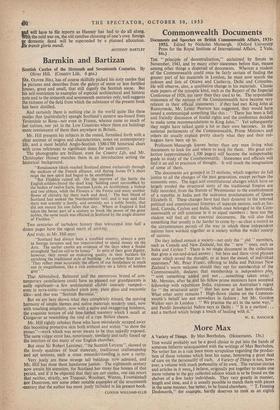Barmkin and Bartizan
Scottish Castles of the Sixteenth and Seventeenth Centuries. By Oliver Hill. (Country Life. 6 gns.) R. Ouvsa Hin,las of course skilfully picked his sixty castles that e pictures and describes from the galaxy of more or less fortified ouses, great and small, that still dignify the Scottish scene. But s self-restriction to examples of especial architectural and historic pote and to the sixteenth and seventeenth centuries only, well suggests the richness of the field from which the substance of the present book has been distilled.
And certainly there is nothing else in the world quite like these castles that (particularly) spangle Scotland's eastern sea-board from Teviotdale to Ross—not even in France, whence came so much of her culture, nor yet in the Low Countries where there are buildings more reminiscent of them than anywhere in Britain.
Mr. Hill presents his subjects in the round, furnished forth with a clear account of origins and characteristics, notes on contemporary life, and a most helpful Anglo-Scottish 1500-1700 historical chart with cross references to significant dates for each country.
The photographs are brilliant, even for Country Life, and Mr. Christopher Hussey matches them in an introduction setting the historical background.
"Renaissance ideals reached Scotland almost exclusively through the medium of the French alliance, and during James 1V's short reign the new spirit had begun to be established.
"But Flodden ruined all. On the morrow of the battle the English soldiers found the dead king 'holding court surrourttled by the bodies of twelve Earls, fourteen Lords, an Archbishop, a bishop and two abbots, while the Flowers o' the Forest and many another flower of chivalry lay there stark and dead.' The best blood of Scotland had soaked the Northumbrian turf, and it was said that there was scarcely a family, and certainly not a noble family, that did not mourn for one fallen that day. Where in England it had taken the better part of a century to break the power of the great nobles, the same result was effected in Scotland by the single disaster of Flodden."
Two centuries of turbulent history thus telescoped into half a dozen pages have the signal merit of sticking.
And truly, as Mr. Hill says: "Scotland had always been a troubled country, always a prey to foreign invasion and too impoverished to spend money on the Arts. The earlier castles are evidence of the days when a feudal stronghold 'had no call to be bonny.' In spite of their grim dignity, however, they reveal an endearing quality in their builders for enriching the traditional style of building. As another Scot put it: 'They reflect most accurately the efforts of our forefathers to reach out to magnificence, like a rich embroidery on a fabric of hodden
grey
That Abbotsford, Balmoral and the monstrous brood of con- temporary castellations could have so pleased our grandparents is sadly significant—a few architectural cliches coarsely vamped— even in terra-cotta—varnished pitch pine, plate glass and encaustic tiles—and that was "Scottish Baronial."
But we are here shown what they completely missed, the moving harmony of simple themes and native materials tenderly used, now with touching simplicity, now with a naive and swaggering boldness, the exquisite texture of old lime-harled masonry which I recall at Craigievar as resembling the rind of a ripe Stilton cheese.
Mr. Hill rightly rebukes those who have mistakenly scraped away this becoming protective skin both without and within "to show the atones"—work which was never meant to be thus nakedly exposed. The same vulgar error has, notoriously, similarly and sadly fussed up the interiors of too many of our English churches.
But since Sir Robert Lorrimer, "the Scottish Lutyens", showed us the lovely qualities of local materials, traditional craftsmanship and apt textures, such a crass misunderstanding is now a rarity.
Very justly are these strange tall buildings now admired, and Mr. Hill has done them handsome justice. The eighteenth century pow awaits his attention, for Scotland has many fine houses of that period, and if it be objected that they are not castles, one can retort that neither, strictly, are Traquair, Woolmet, Winton, Fountainhall for Duntroon, nor some other notable examples of the seventeenth -century that the author has most justly included in his present-book. 1.11
CLOUGH WILLIAMS-ELLIS


































 Previous page
Previous page